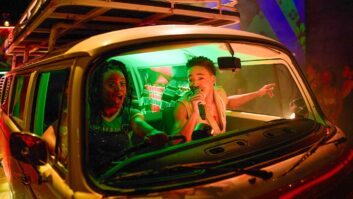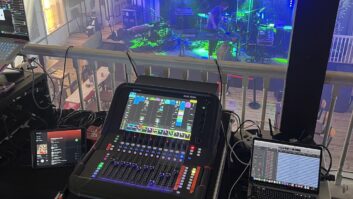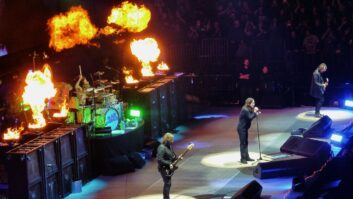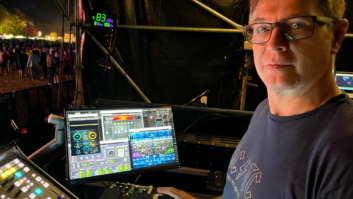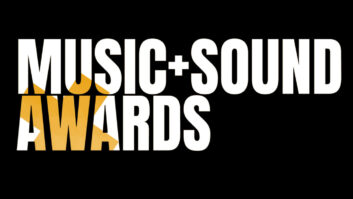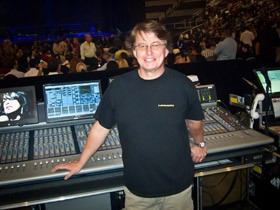
You’d be hard-pressed to not find a digital console on tour. Whether it’s employing snapshots, bringing in plug-ins to re-create an album’s sound, leaving behind racks of outboard or any other number of reasons, many touring engineers prefer to mix digitally. And each engineer has his/her techniques for creating a great-sounding mix. With this in mind, Mix asked some top live sound engineers to give us their tips on working with digital boards.
Chris Madden
CHRIS MADDEN, SADE FRONT-OF-HOUSE ENGINEER
With Sade, I have set up the Avid VENUE in three layers of 24 faders. The first layer has all my drums and percussion: the acoustic kit on channels 1 through 14, then five channels for the drummer’s electronics and five more for the percussion. The second layer is where I’m focused for most of the show. Those faders control Sade’s vocal, the background vocals, saxophone and multiple channels for bass, guitars and keyboards—all the stuff that I tend to want my hands on all the time. The third layer is assigned to the eight channels of playback, spares, ambient mics for recording and other stuff I don’t need to touch very often.
I do use snapshots but in a very subtle way; I build the snapshots gradually. I bring in a few faders, then I bring in some effects, like my reverb, and then I set things in a sort of ballpark range. Then, when I recall a scene, I’ll fine-tune it very gently from there as the band plays. I don’t set everything to an exact setting or level, but over the course of a few shows, there are certain moves I just anticipate. For example, with some tunes we know that the crowd will react a certain way to some parts. With some songs they will get excited at the beginning, so I’ll have the levels set a bit higher, then back them off a bit once the crowd calms down. So I might create a snapshot that’s a bit louder to start the song off, then a second one that backs the level off a few dB.
I also use the VENUE’s virtual soundcheck quite extensively. I honestly haven’t done a live soundcheck for pretty much the entire tour. It’s not just the logistics of getting the band together to do a soundcheck, it’s also the fact that, in truth, musicians will never play with exactly the same energy and intensity during a soundcheck as they will during an actual show. Using virtual soundcheck, I can loop a short section of a song if I want to and experiment with different plug-ins and EQ settings, in an empty hall with a minimum of distractions. It enables me to try out things I’d never have an opportunity to do live, and gives me the opportunity to be far more creative and take chances without the potential of ruining the show.

Craig Brittain
CRAIG BRITTAIN, MICHAEL BUBLE MONITOR ENGINEER
I am lucky in that Solotech is our audio vendor for the Bublé tours and they have put together one very slick touring package. The setup comprises the DiGiCo SD7 console running at 48 kHz with two stage racks, all tied together using Opticore. Both of the stage racks and the FOH racks are housed in a 2×40 double-wide/double-high rack with UPS, etc. The console sits atop a double-wide rack that contains all of our stereo transmitters and receivers.
One interesting thing we initiated with the SD7 early on in our touring cycle was using the AES I/O in the back of the console to route the solo bus (in-ear/solo bus 1) to a pair of matrixes. One physical patch cable in the back routing an AES output to an AES input, along with some soft patching. With the solo bus then coming into 1 and 2 of the matrix, all onstage and offstage talkback mics were then dialed into the matrix. This allowed for myself or my technician to hear any of the talkback mics in our ears whenever they were pushed to talk. One other item of note with the SD7 is that it finally gave me the confidence to rely on the use of snapshots. Never before had I fully trusted the “fire-next” button until the SD7.
JOHN SWORD, CARA DILLON FRONT-OF-HOUSE ENGINEER
This tour has 30 inputs from stage, which means on a Soundcraft VI6 I can run it all and effects on one surface. I will link stereo stuff together using the second layer for the right-side channel. If am using a VI1, I would also link stereo, but side-by-side only. I can hit the box I want quickly and efficiently without having to revert to a center section of controls to change what I want.
As far as the onboard plug-ins, the standard gate, compressor (with de-ess functions and limiting) are good for me. I always like to drive compressors hard but with very low ratios. I really like the Hall reverb on the VI. I will use a dark, long hall around 2 seconds and 100ms pre-delay for general drum reverb; it sits so well behind Paul’s heavy pounding beats. I also have an extra huge 10-second (no pre-delay) hall on hand for one-spot explosion. Vocal reverb will generally use the plate, dark so as not to accentuate a sizzle vocal. These ’verbs can vary from 1.5 to 1.7 seconds, with around 70 to 100ms pre-delay.
I have one tasty tip that I’m sure is not my own but it serves me perfectly. Nearly all artists I mix have a need to fly in effects at certain moments of the music, especially delay. So I have found it very useful to make, for example, two lead vocal channels soft-patched the same. Send whatever effect you want via the applicable aux, take the fader out of left/right so it won’t go through the system. Make sure the aux is post-fade. Then fire in the effect when you need it by riding the fader—effectively an effects send. I used to mix a lot of dub reggae so it’s essential to have your delays on tap for many instruments.

Jason Decter
JASON DECTER, BLINK-182 FRONT-OF-HOUSE ENGINEER
I set up the Midas Pro 9 digital mixing system like I would on a regular analog desk: All my inputs I assign to subgroups, which then get assigned to feed left and right. I have dynamics and EQ privileges on all input channels on the subgroups, plus on left and right. I break down all drum and percussion elements, bass, guitar, keys, vocals, FX returns and matrix outputs. I put a stereo bus compressor on my left and right and use some output gain to make up the difference. The Crane Song HEDD 192HD is what I insert on my left and right. It’s not only a word clock that clocks my desk, but it also gives you tape saturation and second- and third-order harmonics to help shape the mix.

Robert Bull
ROBERT BULL, MARTINA MCBRIDE MONITOR ENGINEER
I’ve mixed on all different types of consoles—both analog and digital, though I am a diehard analog guy—but there are times when analog is just not feasible. When I use a digital console, I prefer a Yamaha PM5D,
Recently, Martina McBride traveled on a chartered Amtrak train from Los Angeles to New York to promote her new album, Eleven, and paired with the Pink Together to raise awareness for breast cancer. We stopped 11 times along the way, performing at the train stations—some indoor, some outdoor. Within 15 minutes of walking off the train, we would have to set up instruments and be show-ready! In these situations, setting up a digital console is key. I would set up my wedge mixes on the Yamaha PM5D on the first five outputs, which are at the top of the output section. Then I set my IEMs on outputs 17 through 24, which is located on the bottom of the output section. This helped me to be quick and accurate. I had graphics set up for my wedge mixes that were assigned to the user-defined keys, 1 through 5, corresponding with wedge outputs. My reverbs were assigned to outputs 23 and 24.
If I am doing fly dates, TV shows or even train stations, the PM5D’s built-in effects and flexibility allow me to assign items where I need them via the user-definable keys. This enables me to walk right up to the console and start mixing. The 5D provides confidence that when a scene is recalled, it is right where I left it. If I am mixing wedges, having my graphic EQs set up on the user-defined keys allows me to get to them very quickly in any situation. When I am using both a PM5D and a DSP5D, the ability to switch between engines is invaluable to have at your fingertips. It helps an old analog brain get the job done.
